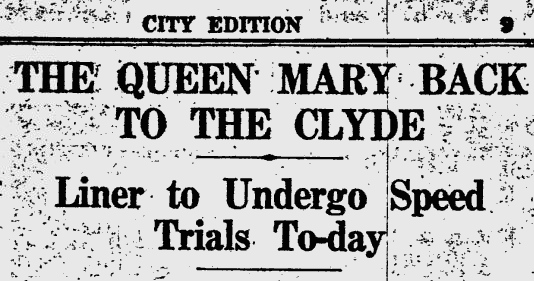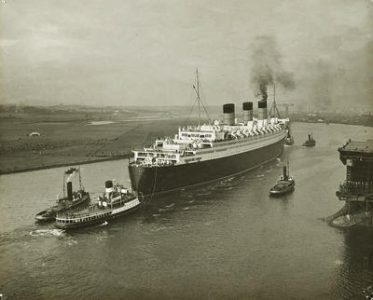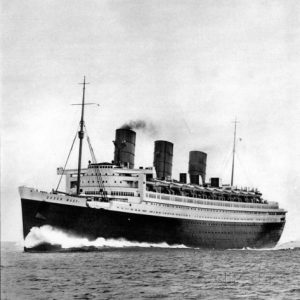
Davaar and Talisman circle the new Cunard liner Queen Mary at the Tail of the Bank on Saturday 18 April 1936 — copyright photo CRSC JTA Brown Collection
The early evening of Saturday 18 April 1936 was exceptional in the annals of the Firth of Clyde. The new Cunard liner Queen Mary — the biggest ship ever built on Clydeside — returned up-firth from a day of sea trials off Arran, and anchored at the Tail of the Bank for three hours before heading for Southampton. While at anchor she was greeted by a fleet of steamers, all laden with sightseers eager to admire the mighty ship.
“Soon after the Queen Mary had anchored [at about 6pm],” reported the Glasgow Herald in its Monday edition, “excursion steamers … from Gourock Pier, Princes Pier, Craigendoran and the Cowal resorts were circling round the ship. Small motor boats also carried full contingents.”
 Among those steamers were the Clyde & Campbeltown Shipping Company’s Davaar and the London and North-Eastern Railway Company’s Talisman. Davaar, already more than 40 years old in 1936, had come up-firth from the Kintyre port that morning. After unloading her cargo and passengers at Greenock’s Princes Pier, she picked up her share of the crowd wanting a close-up of Queen Mary. Later that evening she sailed up river to the Broomielaw, where she lay until heading back to Campbeltown early on the Monday morning.
Among those steamers were the Clyde & Campbeltown Shipping Company’s Davaar and the London and North-Eastern Railway Company’s Talisman. Davaar, already more than 40 years old in 1936, had come up-firth from the Kintyre port that morning. After unloading her cargo and passengers at Greenock’s Princes Pier, she picked up her share of the crowd wanting a close-up of Queen Mary. Later that evening she sailed up river to the Broomielaw, where she lay until heading back to Campbeltown early on the Monday morning.
Talisman’s point of departure was the LNER railhead at Craigendoran on the north bank of the Clyde. Having entered service the previous summer, she was the newest member of the LNER fleet — but this trip round Queen Mary was one of her last in her original livery. She would shortly exchange her black hull for lavender, the hull colouring of the Clyde’s LNER fleet from 1936 until the onset of war in 1939.
 Queen Mary’s gestation had been long and tortuous. Although the keel was laid at John Brown’s Clydebank shipyard as far back as December 1930, construction was interrupted a year later due to the Great Depression, and the launch did not take place until 26 September 1934. When the time finally came for her to edge her way towards the open sea on Tuesday 24 March 1936, well over half a million people lined the banks of the river to watch her progress. After a preliminary run on the measured mile off Arran on March 26, she left the Clyde early the following morning for Southampton, where she was dry-docked. In mid April she underwent continuous steaming trials in the Irish Sea, before arriving back in the Clyde on the evening of Friday 17 April for her official trials.
Queen Mary’s gestation had been long and tortuous. Although the keel was laid at John Brown’s Clydebank shipyard as far back as December 1930, construction was interrupted a year later due to the Great Depression, and the launch did not take place until 26 September 1934. When the time finally came for her to edge her way towards the open sea on Tuesday 24 March 1936, well over half a million people lined the banks of the river to watch her progress. After a preliminary run on the measured mile off Arran on March 26, she left the Clyde early the following morning for Southampton, where she was dry-docked. In mid April she underwent continuous steaming trials in the Irish Sea, before arriving back in the Clyde on the evening of Friday 17 April for her official trials.
“She was expected at Gourock at half-past six, and almost exactly to the minute her shapely bows were seen from the pier rounding McInroy’s Point,” noted the Herald the following morning. “She appeared to be steaming very fast, and in a few minutes she had reached the usual anchorage between Gourock and Kilcreggan. At a quarter to seven she had swung round, facing westwards, and with a rumble like thunder, which reverberated over the waters, her starboard anchor was dropped. The port one followed almost immediately. Soon after, the tide had swung her further round until she was facing down the Firth, presenting again a broadside view to the watchers on both shores.”
 After raising anchor before sunrise on Saturday 18 April, she spent the day in the lower reaches of the Firth, carrying out speed trials between 10am and 3pm in 22 fathoms of water off the east coast of Arran. “The first indication dwellers in the villages of Corrie and Sannox received of the vessel’s presence was a long sustained roll, like thunder, in the stillness of the early morning,” enthused the Herald in its Monday edition, noting that unofficial timekeepers had recorded a top speed of 32.84 knots. “Many people awakened to discover that the noise was the surge of breakers on the beach… From a high point on the hill great white breakers could be seen dashing on to the south end of Bute, Little Cumbrae and the island of Inchmarnock. The ship presented a striking spectacle as she steamed close inshore with the sun glistening on her superstructure and picking out her polished brasswork.”
After raising anchor before sunrise on Saturday 18 April, she spent the day in the lower reaches of the Firth, carrying out speed trials between 10am and 3pm in 22 fathoms of water off the east coast of Arran. “The first indication dwellers in the villages of Corrie and Sannox received of the vessel’s presence was a long sustained roll, like thunder, in the stillness of the early morning,” enthused the Herald in its Monday edition, noting that unofficial timekeepers had recorded a top speed of 32.84 knots. “Many people awakened to discover that the noise was the surge of breakers on the beach… From a high point on the hill great white breakers could be seen dashing on to the south end of Bute, Little Cumbrae and the island of Inchmarnock. The ship presented a striking spectacle as she steamed close inshore with the sun glistening on her superstructure and picking out her polished brasswork.”
It was shortly after one of these runs that Davaar, en route from Kintyre to Greenock, caught her first glimpse of the Cunarder at sea. The Herald described how, having called at Lochranza and proceeded round the Cock of Arran in the direction of Garroch Head, Davaar “passed across the course soon after the liner had finished one of her runs, while later the Campbeltown-bound steamer Dalriada, which also passed nearby, blew a blast of welcome on her siren, and was answered with the deep reverberating note of the Queen Mary’s siren, awakening echoes in the hills.”
 On completion of her last trial run, the liner returned up-firth to be fêted by Davaar, Talisman and at least six other steamers at her anchorage at the Tail of the Bank. “During the evening Gourock was thronged with thousands of visitors,” the newspaper continued. “They arrived by train and bus, on cycles and on foot, and there was an almost unending stream of motor cars passing through the crowded streets. The population of the town is 9,000, and it is estimated that on Saturday night it increased to 100,000. Vendors did a good trade selling Queen Mary souvenirs, some of them made in Czechoslovakia. Remarkable scenes were witnessed at the station as special train after special train discharged its complement of passengers, and as the evening advanced crowds were queuing up for outgoing trains as other trains were arriving.”
On completion of her last trial run, the liner returned up-firth to be fêted by Davaar, Talisman and at least six other steamers at her anchorage at the Tail of the Bank. “During the evening Gourock was thronged with thousands of visitors,” the newspaper continued. “They arrived by train and bus, on cycles and on foot, and there was an almost unending stream of motor cars passing through the crowded streets. The population of the town is 9,000, and it is estimated that on Saturday night it increased to 100,000. Vendors did a good trade selling Queen Mary souvenirs, some of them made in Czechoslovakia. Remarkable scenes were witnessed at the station as special train after special train discharged its complement of passengers, and as the evening advanced crowds were queuing up for outgoing trains as other trains were arriving.”
The liner did not wait long. At 9.40pm she weighed anchor and, ablaze with light, was soon steaming majestically down-firth on the way to Southampton. “Visibility was perfect, and all down the coast sightseers gathered on the shores to get their last view of the liner… After Queen Mary had left visitors were still pouring into Gourock and it was not until after midnight that the town returned to its normal condition.”
Queen Mary anchored in Cowes Roads 24 hours later, and undertook her maiden voyage via Cherbourg to New York on May 27. In August 1936 she captured the Blue Riband for the fastest crossings of the Atlantic. She was withdrawn from service in 1967, and since December of that year has been permanently moored at Long Beach, California.












